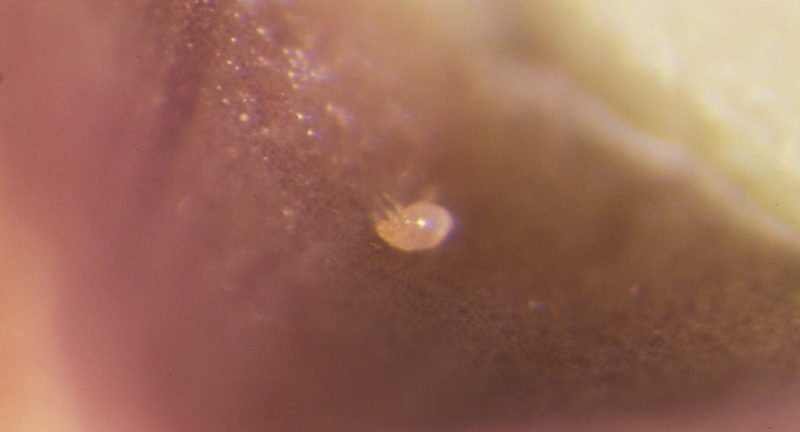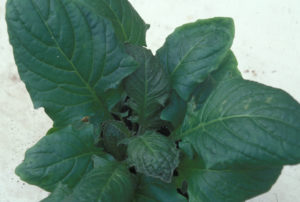
Revisiting Broad Mite
Question: Broad mites seem to be more of a problem and are very difficult to control. What are your recommendations for managing this pest?
Answer: Yes, I would agree that broad mites are becoming more of an issue feeding on many greenhouse-grown horticultural crops (ornamental and vegetable) including: begonia, browallia, chrysanthemum, cucumber, dahlia, eggplant, English ivy, fuchsia, impatiens, New Guinea impatiens, pepper, salvia, snapdragon, strawberry, tomato, torenia and transvaal daisy.
First of all, what are broad mites? Broad mite (Polyphagotarsonemus latus) is a tarsonemid mite very closely related to and similar in appearance to the cyclamen mite (Phytonemus pallidus). Adult broad mites are about 0.25 mm (0.0098 inches) long, oval-shaped, shiny and light yellow to amber (Figure 1). The hind legs appear whip-like. Broad mite has four life stages including: egg, larva, nymph and adult.

Females can lay up to 40 eggs during their two-week life span, although the number of eggs laid depends on temperature and relative humidity. Unmated females produce only males, whereas mated females produce females. Eggs are oval, white and covered with bumps (Figure 2). Six-legged larvae emerge (eclose) from eggs, transition into egglegged nymphs, and then become adults. Development from egg to adult takes five to six days at 70 to 80° F and seven to 10 days at 50 to 65° F.
Broad mite populations can spread within greenhouses by means of air currents, especially those created by horizontal air-flow fans, leaves of adjacent plants touching, and workers (employees) handling infested plants and then touching noninfested plants.
Broad mites tend to aggregate in groups, feeding primarily on leaf undersides and flowers where females lay eggs. They feed on plant cells within the leaf epidermis using their piercing-sucking mouthparts. While feeding, broad mites inject a toxic salvia that causes twisted, hardened and distorted terminal plant growth.

Additional symptoms include: leaf bronzing, leaf margins curling downward and becoming brittle, and puckered and shriveled growth. Extensive populations of broad mites will lead to individuals migrating and feeding on the upper leaf surface, which can result in severe leaf distortion. Broad mite feeding damages the meristematic plant tissues associated with the growing tip or apical shoot, which inhibits growth; decreases leaf number, leaf size and area; and reduces plant height. In addition, leaves may appear “roughened” and darker green than normal (Figure 3). Broad mite damage to salvia is shown in Figure 4.
Broad mite damage resembles nutritional deficiencies, herbicide damage, watering problems, or improper environmental conditions (e.g., temperature and relative humidity). Therefore, to correctly identify a broad mite problem, it is important to verify using a dissecting microscope.
Broad mite management involves disposing of all plants confirmed to be infested with broad mites. In addition to discarding plants exhibiting damage symptoms, remove plants adjacent to infested plants, even if they are not showing symptoms, because the plants may be infested with broad mites.
There are a number of pesticides with miticidal activity registered for use against broad mite listed in Table 1. Those pesticides with translaminar properties may be more effective because the material penetrates leaf tissues, forming a reservoir of active ingredient within leaves or new terminal growth. Consequently, these pesticides are likely to contact broad mites feeding within the meristematic tissues.
Biological control of broad mite involves preventative releases of the predatory mites, Neoseiulus cucumeris or N. californicus. It is important to release the predatory mites early in the crop production cycle before broad mite populations become established and plant damage is noticed. Consult a biological control supplier to determine the appropriate release rates. For more information on broad mite, refer to the following Extension publication: www.bookstore.ksre.ksu.edu/pubs/MF2938.pdf.


 Video Library
Video Library 




















